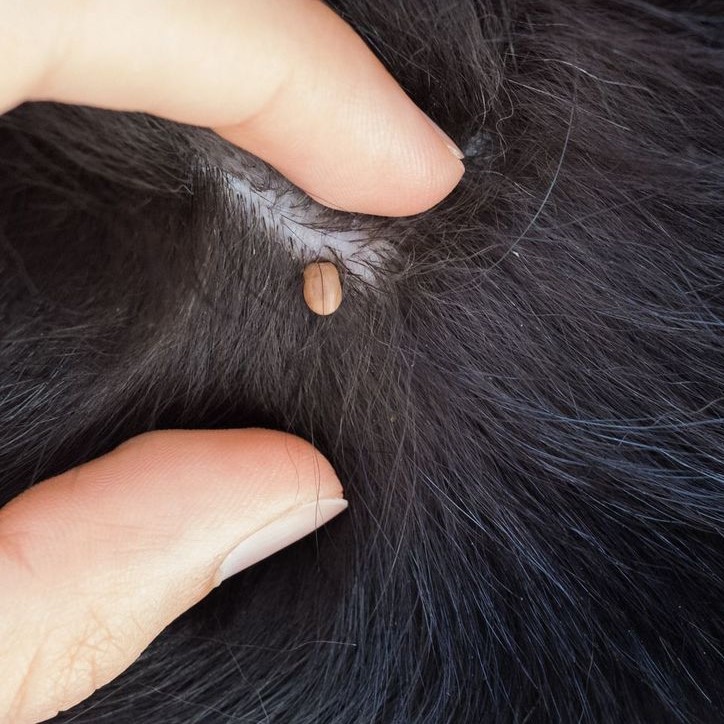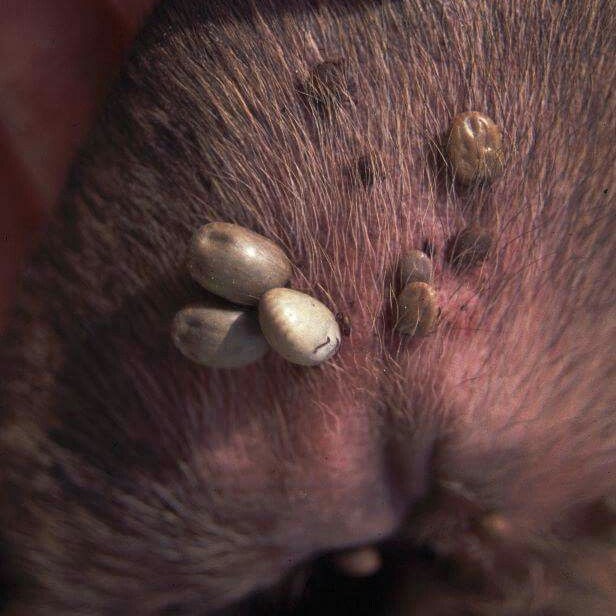Introduction: Understanding the Threat of Ticks on Dogs
Ticks are more than a mere nuisance—they are a serious health threat to dogs and their owners. The presence of a tick on dog skin can lead to various health issues, including diseases that affect not only our pets but also our families. As summer and warmer months approach, tick populations often rise, making it essential for dog owners to stay informed about the risks associated with these parasites. In this guide, we will cover the signs of tick infestations, effective treatments for ticks, and vital prevention strategies to keep your furry friend safe.

Understanding Ticks: Types and Characteristics
1. What Are Ticks?
Ticks are ectoparasites, meaning they live on the outside of a host and feed on their blood. They belong to the arachnid family, which also includes spiders and mites. Understanding the types of ticks that affect dogs is crucial in recognizing and dealing with them effectively.
- Black-Legged Tick (Deer Tick): Known for transmitting Lyme disease, these ticks are prevalent in wooded and grassy areas. Recognizable by their small size, they can be hard to spot, especially in a dog’s fur.
- American Dog Tick: This tick is commonly found in outdoor environments and is known to spread diseases such as Rocky Mountain spotted fever. It has a mottled brown appearance and is typically found in tall grass and shrubs.
- Brown Dog Tick: Unlike other ticks, the Brown Dog Tick primarily infests dogs and can thrive indoors. They can lead to serious health risks if not addressed promptly.
2. Life Cycle of Ticks
Ticks undergo several life stages: larva, nymph, and adult. Each stage requires a blood meal to progress to the next. Understanding this life cycle helps dog owners know when ticks are most likely to attach:
- Larval Stage: After hatching from eggs, larvae seek out small mammals, where they obtain their first blood meal.
- Nymph Stage: Once they have fed, they drop off, molt, and eventually emerge as nymphs. Nymphs often seek larger hosts, including dogs and humans.
- Adult Stage: Adult ticks are larger and can feed for several days. They seek out hosts for their next blood meal and can transmit diseases more effectively during this stage.
Signs of Tick Infestations on Dog Skin
1. Visible Ticks
One of the most evident signs of a tick infestation is spotting the ticks themselves. Ticks can be found attached to various parts of your dog’s body, commonly in regions with thinner fur:
- Common Areas to Check: Ears, groin, armpits, and between toes are popular hiding spots for ticks. Regularly inspecting these areas after outdoor activities can help catch infestations early.
- How to Inspect: Use your fingers to feel along your dog’s skin for any lumps or hard bumps that may indicate a tick attachment. If your dog has longer fur, a fine-toothed comb may assist in detecting ticks more effectively.
2. Skin Irritation
Ticks can cause irritation to your pet’s skin, which may manifest in several ways:
- Redness and Swelling: Around the bite area, you might notice redness, swelling, or even a rash. The skin may appear inflamed, signaling that the tick has been feeding.
- Scratching and Biting: If your dog scratches or bites at a certain area more than usual, it may be trying to relieve the discomfort caused by a tick.
3. Behavioral Changes
Ticks can cause your dog to exhibit noticeable changes in behavior:
- Restlessness: If your dog is unusually restless or seems anxious, it could signal discomfort caused by ticks.
- Lethargy: Conversely, if your dog appears lethargic or lacks energy, this could also indicate tick-borne illness.
4. Symptoms of Tick-Borne Diseases
If ticks transmit a disease, your dog may show additional symptoms that require attention. Common signs include:
Fever
- Definition of Fever: A fever is generally defined as an elevated body temperature compared to your dog’s normal range, which typically falls between 101°F and 102.5°F (38.3°C to 39.2°C).
- Early Indicator of Illness: An elevated body temperature is commonly one of the first signs that a dog may be ill, especially in the context of tick exposure. It serves as a natural defense mechanism that the body uses to fight infections.
- How to Check for Fever: Monitoring your dog’s temperature can be done using a digital rectal thermometer specifically designed for pets. It’s essential to do this gently and keep your dog calm to ensure an accurate reading.
- Additional Signs Accompanying Fever: Along with elevated temperature, other symptoms may manifest, including lethargy, shivering, or sweating. If a fever persists beyond a day, it’s important to seek veterinary advice promptly.
Loss of Appetite
- Understanding Loss of Appetite: A reluctance to eat or drink is a significant red flag indicating that your dog may be experiencing discomfort or health issues.
- Possible Indications of Underlying Problems: If your dog, who usually enjoys food, suddenly becomes uninterested in meals, it could be a direct result of tick exposure and the diseases they can transmit.
- Signs to Look For: Besides refusing food, you may notice that your dog is not drinking water or consuming less than usual. This can lead to dehydration, compounding the health problems.
- Behavioral Changes: Often, alongside loss of appetite, dogs may appear lethargic, irritable, or lethargic. Monitoring these changes can provide insight into their overall health and well-being.
Joint Pain or Limping
- Connection Between Tick Bites and Joint Pain: Certain diseases transmitted by ticks, such as Lyme disease, can lead to inflammation in the joints. This results in discomfort, which may manifest as pain or stiffness.
- Indications of Joint Pain: If your dog is hesitating to jump, running less than usual, or showing reluctance to climb stairs, these may be signs of joint pain resulting from tick-borne diseases.
- Signs of Limping: Limping, or favoring one leg over another, is a key symptom of pain. This indicates that your dog might be experiencing joint pain or stiffness due to inflammation.
- Need for Veterinary Care: Persistent joint pain or limping should prompt immediate veterinary attention. A veterinarian can perform diagnostic tests to determine the exact cause of these symptoms and recommend appropriate treatments.
Removing Ticks from Dog Skin
1. How to Remove a Tick Safely
If you find a tick attached to your dog, prompt removal is crucial to minimize health risks. Here’s how to do it safely:
- Use Fine-Tipped Tweezers: Grasp the tick as close to your dog’s skin as possible. Pull upward with steady, even pressure. Avoid twisting or jerking motions, as these may cause parts of the tick to remain embedded.
- Dispose of the Tick Properly: After removal, place the tick in a sealed container or bag. Write down the date and location of the removal. This information can be helpful for your veterinarian if your dog shows any symptoms later.
2. Clean the Bite Area
Once the tick is removed, cleaning the area is crucial:
- Disinfect the Area: Clean the bite area with rubbing alcohol or soap and water. This helps prevent infection and promotes healing.
3. Monitor for Symptoms
After removing the tick on dog skin, keep an eye on the bite area and your dog’s behavior:
- Signs of Infection: Watch for redness, swelling, or pus around the bite site. If any symptoms arise, consult your veterinarian.
- Be Aware of Further Symptoms: Observe your dog for any signs of tick-borne diseases over the next few weeks, such as lethargy, fever, or joint pain.
Treating Tick Infestations
1. Veterinary Consultation
If you’re unsure about the tick removal process, or if your dog displays worrying symptoms:
- Seek Professional Help: Veterinarians can recommend appropriate testing for tick-borne diseases and may prescribe medications to relieve symptoms.
- Discuss Preventive Measures: Talk to your vet about preventive treatments, including flea and tick products, that can protect your dog from future infestations.
2. Home Remedies and Over-the-Counter Treatments
While not a substitute for professional care, certain remedies may provide relief:
- Aloe Vera: Applying aloe vera gel to the area can soothe irritation after tick removal.
- Natural Oils: Some natural oils, like peppermint or lavender, have antimicrobial properties. However, always consult your veterinarian before applying any essential oils to ensure they are safe for your dog.
Preventing Ticks on Dog Skin
1. Regular Grooming Habits
Grooming plays a vital role in tick prevention:
- Frequent Inspections: Regularly check your dog’s skin for ticks, especially after walks in grassy or wooded areas. Make this a part of your grooming routine.
- Baths: Using dog-safe shampoos can help remove ticks that may have recently attached. Consider periodic bathing during tick season.
2. Using Preventive Treatments
Employing ticks prevention strategies is essential to keeping your dog safe:
- Topical Treatments: Apply topical treatments that help repel and kill ticks. These are usually effective for a month or more.
- Oral Medications: Discuss oral tick prevention medications with your veterinarian, which can provide longer-lasting protection against ticks and fleas.
- Tick Collars: Certain collars release chemicals that repel ticks. Ensure you select a collar appropriate for your dog’s size and breed.
3. Maintaining a Tick-Free Environment
Creating a tick-safe environment can significantly reduce the risk of infestation:
- Yard Maintenance: Mow grass regularly and keep shrubs trimmed to eliminate potential tick habitats.
- Secure Fencing: Fencing your yard helps keep wildlife away, which can bring ticks closer to your home.
- Avoiding High Risk Areas: When walking your dog, try to stay on paved paths and avoid thick brush or tall grass where ticks thrive.
Conclusion: Prioritize Your Dog’s Safety
In conclusion, managing tick on dog skin is essential for the health and safety of your canine companion. Understanding their nature, recognizing signs of infestations, and employing effective treatments and prevention strategies can make a significant difference in keeping your pet safe.
Regular grooming, the use of preventive medications, and maintaining a well-kept environment will go a long way in safeguarding your furry friend from ticks and the diseases they carry. As a responsible dog owner, it’s your duty to stay informed and proactive in protecting your beloved pet.
Taking these measures shows your dedication and care, ensuring a long, happy, and healthy life for your dog. Don’t wait for a tick infestation to act; be proactive and make tick prevention a priority today!













